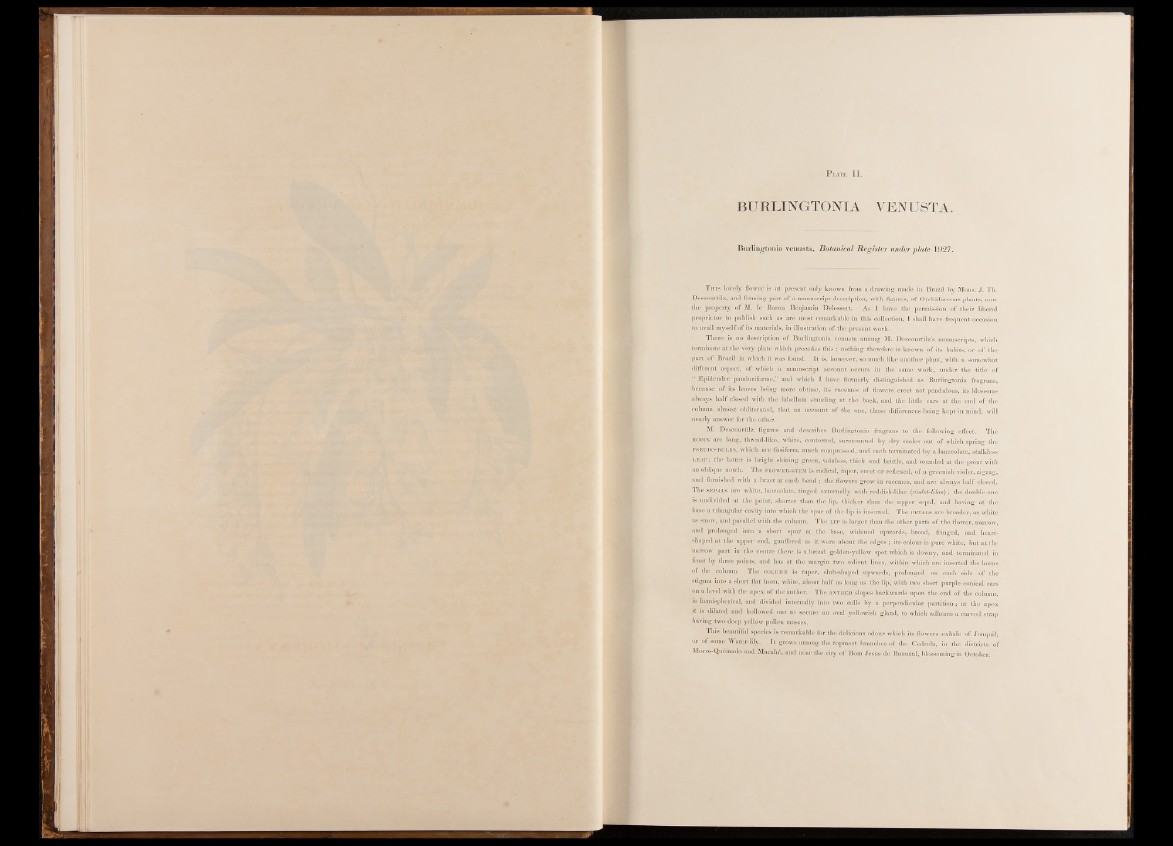
P late IL
BURLINGTONIA YENUSTA.
Burlingtonia venusta, Botanical Register under plate 1927.
This lovely flower is at present only known from a drawing made in Brazil by Mons. J. Th.
Descourtilz, and forming part of a manuscript description, with figures, of Orchidaceous plants, now
the property of M. le Baron Benjamin Delessert. As I have the permission of their libéral
proprietor to publish such as are most remarkable in this collection, I shall have frequent occasion
to avail myself of its materials, in illustration of the present work.
There is no description of Burlingtonia venusta among M. Descourtilz’s manuscripts, which
terminate at the very plate which precedes this ; nothing therefore is known of its habits, or of the
part of Brazil in which it was found. It is, however, so much like another plant, with a somewhat
different aspect, of which a manuscript account occurs in the same work,, . under the title of
“ Epidendre panduriforme,” and which I have formerly distinguished as Burlingtonia fragrans,
because of its leaves being more obtuse, its racemes of flowers erect not pendulous, its blossoms
always half clösèd with the labellum standing at the back, and the little ears at the end o f the
column almost obliterated, that an account of the one, these differences being kept in mind, will
nearly answer for the other.
M. Descourtilz, figures and describes Burlingtonia fragrans to the following effect. The
hoots are long, thread-like, white, contorted, surmounted by dry scales out of which spring the
pseudo-bulbs, which are fusiform, much compressed, and each terminated by a lanceolate, stalkless
leaf ; the latter is bright shining green, veinless, thick and brittle, and rounded at the point with
an oblique notch. The flower-stem is radical, taper, erect or reflexed, of a greenish violet, zigzag,
and furnished with a bract at each bend ; the flowers grow in racemes, and are always half closed.
The sepals are white, lanceolate, tinged externally with reddish-lilac (violet:Mas)^the double one
is undivided at the point, shorter than the lip, thicker than the upper sepal, and having at the
base a triangular cavity into which the spur of the lip is inserted. The petals are broader, as white
as snow, and parallel with the column. The lip is larger than the other parts of the flower, narrow,
and prolonged into a short spur at the base, widened upwards, broad,; fringed,' and heart-
shaped at the upper end, gauffered as it were about thé edges ; its colour is pure white, but at the
narrow part in the centre there is a broad golden-yellow spot which is downy, and terminated in
front by three points, and has at the margin two salient lines, within which are inserted the horns
the column. The column is taper, club-shaped upwards, prolonged on each side of the
stigma into a short flat horn, white, about half as long as the lip, with two short purple conical ears
on a level with the apex of the anther. The anther slopes backwards upon the end of the column,
is hemispherical, and divided internally into two cells by a perpendicular partition ; at the apex
it is dilated and hollowed out to secure an oval yellowish gland, to which adheres a curved strap
having two deep yellow pollen masses.
This beautiful species is remarkable for thé delicious odour which its flowers exhale of Jonquil,
of of some Water-lily. It grows among the topmost branches of the Cedrela, in the districts of
Morro-Quémado and Macahé, and near the city of Bom Jesus de Banaiial, blossoming in October.